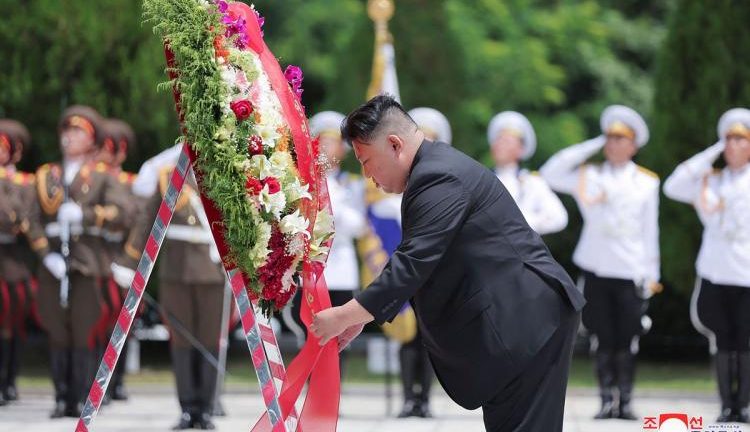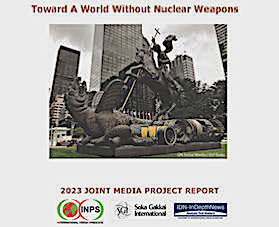By Joseph Gerson*
NEW YORK. 9 August 2023 (IDN) — Along with the obvious and increasing military tensions across the Taiwan Strait and in the South China/West Philippine Sea, the continuing danger that confrontational policies, arms racing, and provocative military operations across and around the Korean Peninsula could all too easily trigger escalation to the unthinkable.
It’s only an accident or miscalculation away, including the danger that an accident or miscalculation could much too easily trigger a catastrophic nuclear war. The increasing Korean and regional Northeast Asian tensions are such that peace organizations in Seoul are preparing to launch an “Early Warning” to prevent armed conflict in Northeast Asia.
Moreover, the solemn 27 July civil society ceremony at the DMZ that marked the 70th Anniversary of the 1953 Armistice Agreement decried “the vicious cycle of the arms race and mutual threats.”
The peninsula, neighboring nations, and the United States are now caught up in an escalating arms race, compounded by the absence of common security diplomacy.
On the surface, the escalating danger was marked by the port call of the USS Michigan, a U.S. nuclear-armed U.S. submarine, to Busan in South Korea. It was the first U.S. introduction of U.S. nuclear weapons to the ROK since 1981 at the height of the Cold War.
The port call came amidst the increasing pace of massive U.S.-South Korean-Japanese joint military operations, termed “exercises,” designed to demonstrate the allies’ ability to destroy North Korea and its political leadership, including the Kim Dynasty.
And, with its frequent missile tests, including intercontinental ballistic missiles thought to be able to reach the United States, and its history of nuclear weapons tests, North Korea is demonstrating that even a lowly porcupine can inflict devastating wounds and defeat an intimidating tiger.
Unfortunately, the growing danger is rooted in history and powerful structural forces. Peace can only be built on mutual trust, lacking in Northeast Asia. Why?
Because Secretary Blinken’s offer to negotiate without preconditions was not accompanied by decreasing the pace of threatening U.S., ROK and Japanese military operations and not with even a symbolic reduction in “hostile” military actions.
In the North, its leaders and people were traumatized by the almost complete destruction of the nation. 90% of its buildings were estimated to have been destroyed. And the Trump-Bolton reverse course at the 2018 Hanoi summit, in which the U.S. abandoned pursuit of step-by-step denuclearization and demanded total immediate North Korean nuclear disarmament, left Pyongyang believing that a negotiating path with the U.S. cannot be trusted.
And on the U.S. side, the North’s history of secretly creating an HEU (highly enriched uranium) path to develop nuclear weapons rings across the years.
There is more. As part of its campaign to reinforce U.S. Asia-Pacific hegemony in the face of China’s rise and its implicit threat to U.S. regional hegemony, the U.S. has deepened and expanded a trilateral alliance with the right-wing Yoon government in South Korea and the Kishida government in Tokyo, which is doubling its already massive military budget as it reasserts Japanese status and role as a major military power.
And on the continent, China, Russia, and North Korea are deepening their military cooperation, as illustrated on 27 July with the joint Chinese-Russian delegation to the DPRK’s victory celebration marking the Armistice anniversary.
With North Korean and Russian conventional military capacities lagging far behind those of the ROK, Japan, for years to come—if war doesn’t break out before then—the U.S., Pyongyang, and Moscow will rely increasingly on their nuclear arsenals to defend their elites perceived interests. This is compounded by the first-strike doctrines of all the parties to Northeast Asian tensions, except China.
If triggered, they would kill millions across the region and likely escalate to an apocalyptic nuclear that would leave the living envying the dead. The Biden Administration’s Nuclear Posture Review reaffirmed the fist strike doctrine and dispatched the first of many nuclear-armed submarines to South Korea.
Japan has adopted a conventional first-strike doctrine designed to disarm North Korea or China with U.S.-purchased cruise missiles proactively. Seoul relies on U.S. first-strike extended deterrence. This past year, North Korea adopted a law that constitutionally embeds its first-strike doctrine.
Russia’s first-strike doctrine has been in place almost as long as that of the U.S., And a Japanese launch of cruise missiles would likely lead to using them or losing them, triggering Beijing’s nuclear arsenal.
In the face of these growing dangers, in South Korea, peace movements and their partner organizations from the U.S. to Mongolia were urging “a common voice against the arms race, the military buildup, and the escalation of hostile language and actions of national leaders”.
There is recognition that the current crisis is not simply between North and South Korea but is “centered on the U.S.-China rivalry.” Diplomacy must proceed along at least two tracks: First, in response to popular demands to prevent a catastrophic war, the U.S.-Japan-ROK alliance and North Korean-Chinese-Russian triangle signaling commitments to de-escalate tensions by reducing their provocative military operations.
A reduction in “hostile actions” could lead to strategic stability and, ultimately, arms control and disarmament negotiations. And ultimately, as was the case of the Intermediate Nuclear Forces (INF) Treaty, which ended to Cold War in Europe in 1987, before the fall of the Berlin Wall, all sides must find ways to common security diplomacy based on the truth that security can only be created with, not against, a nation’s rival. The alternative being spiraling arms races that trigger the catastrophe that no one wants.
The hour is indeed getting late. Given the militarized nationalism of all the contending powers in Northeast Asia, the demands to finally end the Korean War with a Peace Treaty and to stop the arms racing and provocative military operations must come from popular society. When the people lead, the leaders will follow.
*Dr. Joseph Gerson is President of the Campaign for Peace, Disarmament and Common Security. He recently participated in Common Security and 70th Anniversary of the Korean Armistice conferences and events in South Korea. [IDN-InDepthNews]
Photo: This undated picture released by North Korea’s official Korean Central News Agency (KCNA) on 26 July 2023 shows North Korean leader Kim Jong Un (central) laying a wreath at the Chinese People’s Volunteers Martyrs’ Cemetery in South Pyongan Province ahead of the 70th Anniversary of the victory of the Fatherland Liberation War. Photo: VCG













